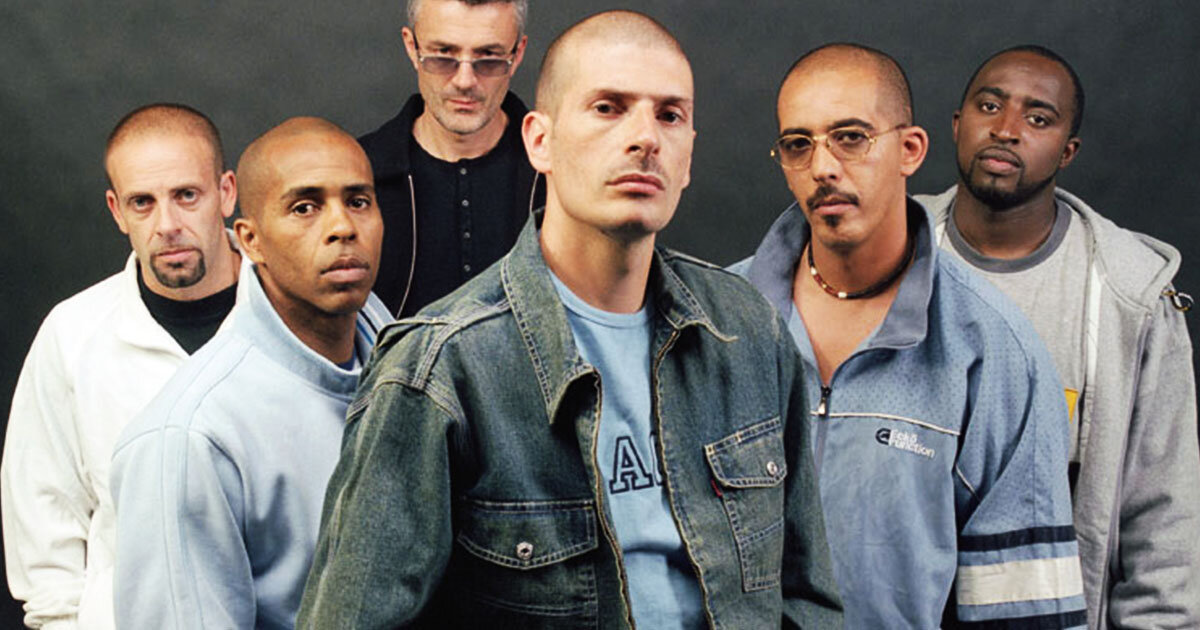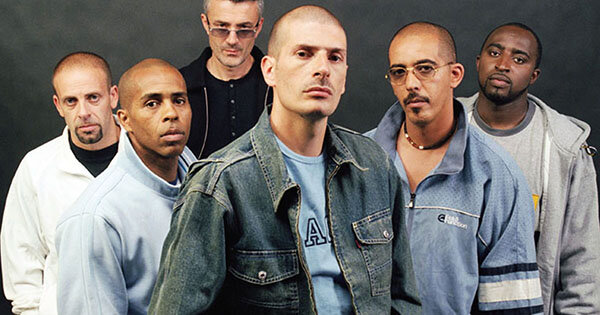The original Marseille rap collective IAM. <
<
Melissa Chemam
Who in France did not dance the “Mia” in 1994? The track on the second album of IAM’s Ombre est lumière made this collective of rappers and breakdancers from Marseille — absolute fans of New York rap — known throughout the country. If IAM remains little known to the English-speaking public, it nevertheless reflects the incredible journey of French rap, and the unexpected appearance of Marseille on the cultural map.
“Mia” was a dance explosion but also the chronicle of a city that until then had only made rare appearances on French television, almost always on the nightly news. The song invaded the French media space with a video clip directed by the filmmaker Michel Gondry, who worked at the time with the biggest stars of music, from Björk to Massive Attack.
“In the early 80’s, I remember the parties / Where the atmosphere was hot and the guys would come in / Stan Smith on their feet, looking cold,” rapper Akhenaton, whose real name is Philippe Fragione, intones: “They scanned the room with the three-quarter leather rolled around their arm,” all over a sample of George Benson’s “Give Me the Night”, released in 1980, slowed down and covered with hip-hop pulses.
“This song eludes all known musical references,” wrote Jean-Marie Jacono in the popular music magazine Volume! in 2004. “It’s neither a typical rap song nor a dance song, even if it evokes the parties of the Marseille nightclubs of the 1980s.”
It propelled the rap group — still a relatively underground genre in France in 1993/94 — to the forefront – a first for a group from Marseille. “‘Je danse le mia’ was revenge, not only for Marseille, but for the whole of France on Paris,” says music journalist Rebecca Manzoni, of the national radio station France Inter.
But the way was long before leading to this small jewel of French rap…
The origins: a sound exploration from the Planet Mars
To understand this unexpected path, we have to go back to 1985, when the young Philippe Fragione and Eric Mazel join the team of “Vibrationn”, a program created by Philippe Subrini on Radio Sprint. They formed a first group in 1986 called Lively Crew, very inspired by New York rap, which included five members called Akhenaton, DJ Kheops, Nasty Mister Bollocks, MCP One and Studio.
They gave their first concert in March 1986 in the 7th district of Marseille, in a festival of reggae upon the invitation of Massilia Sound System, a group of Occitan expression founded in 1984. The following year, Akhenaton and Kheops left to spend the summer in New York, where they hunted for records. The sounds that inspired them were those of Kool G Rap, Rakim, Big Daddy Kane, Wutang Clan, Run DMC.
Back in Marseille, Akhenaton and Kheops join Shurik ‘n and Kephren of the group B-Boy Stance and in 1988 take the name IAM, acronym of Imperial Asiatic Man. The group was inspired by Asian and Egyptian mythology and popular cinema. Two other members joined them in 1989: Imhotep and Freeman. All of them, except one, have taken the names of pharaohs: Akhenaton, Cheops, Imhotep and Kephren.
The group toured France, then recorded a first album entitled De La Planète Mars, which was released in March 1991. IAM claimed its Marseille heritage and considered it a “full-scale attack from the planet Mars.” The album went gold a few years after its release.
They also add North African rhythms and instruments.
And their storytelling rap evokes the proximity of the city of Marseille to the African continent.
“Even if the group remains musically very New York,” explains music critic Bertrand Dicale, “it is from the beginning very creative, with reggae influences, a claimed ethnic diversity — it brings together an Italian, a Comorian/Malagasy, an Algerian, Muslims and a ‘Frenchman’. In this, they are deeply Marseillais. But at the same time, the group rejects clichés: with Shurik’n and Akhenaton, you don’t hear local stereotypes about pastis, creeks, sunshine…”
It is above all the rest of the world and the immigrants in their consciousness and their authentic stories that the group reflects, speaking of colonization and immigrant working classes. IAM depicts Marseille as a city open to the world, made of multiple layers of immigration, which has gone through many crises and a certain poverty.
Early in 1993, the Delabel record company offered them a budget that allowed them to record a second album in Aix-en-Provence, and to mix in New York. As Shurik’n remembers, “It was the first time we were together for so long to make music.” And this album would transform the French rap planet.
Ombre est lumière : The other pole of French rap
Paris was the epicenter of French hip-hop and one of the world capitals of the graffiti scene in the early 1980s, incubating groups like Suprême NTM and Assassin in its suburbs, followed by the rapper MC Solaar, particularly in Saint-Denis, in the northeast of the capital.
With IAM, it is not only a group that was born in Marseille, it is a whole generation. Shurik’n often says: “You kick a building and three rappers fall out!”
For Arnaud Rollet, former editor-in-chief of the music magazine Trax and author of the book Rencontres du troisième beat: les ovnis de l’électro, IAM “is the rap equivalent of Notre-Dame de la Garde and the OM, quite simply: a monument, a source of pride and something that unites the people of Marseille. It’s a group from Marseille that manages to speak to everyone, even when it talks about Marseille, and that’s strong. And IAM has clearly shown the way to the rappers of Marseille, by telling them ‘it’s possible’. Without them, no Fonky Family or Jul.”
Ombre est Lumière, released in November 1993, the first double album in the history of rap, is considered by Akhenaton “the emblematic album of the IAM spirit.” After the release of “Je danse le mia”, hit of summer 1994, the group found major success. Beyond the “Mia”, IAM works a dark music and a socially committed rap.
IAM, a francophone case study
In 1997, the five Marseille pharaohs returned with a master stroke: L’Ecole du micro d’argent. Very narrative, with numerous cinematographic references — from the great Westerns to Stars Wars — this album imposed an aestheticized warlike universe.
Titles such as “Petit Frère” and “Nés sous la même étoile” describe the social reality of a class of men deprived of social ascension, but who refuse violence and cultivate honor, spirituality and self-esteem. The lyrics are notably marked by the Muslim faith of Shurik’n and Akhenaton, an Italian-French convert.
For many critics, L’Ecole du Micro d’Argent is at the level of the best American rap. Two of its highlights come with the tracks “La Saga” (which features rappers from the Brooklyn group Sunz Of Man) and “Demain, c’est loin”.
L’Ecole du Micro d’Argent is rewarded by two Victoires de la musique.
Akhenaton, Shurik’n, Kheops and Freeman began solo careers in parallel. IAM composed with other collectives and rappers from Marseille the soundtrack of the films Taxi 1 and 2 produced and written by Luc Besson, which were major box office hits. Then IAM released a fourth album, and a fifth in 2003, Revoir un printemps. Though these albums didn’t achieve the success of previous ones, IAM kept the myth alive.
“While I was always enamored with the flow and cadence of IAM’s beat, it took me seeing Marseille to deeply understand where they were getting their style from, from a cultural perspective, that energy that was so unique and singular,” Anglo-American author and radio man Johny Pitts writes in his book Afropeans (out in the U.K. in 2019 and in France in 2020). “Not only did the group play to Wu-Tang Clan as a precursor — about two to three years earlier, but their choice to look at North African history, as well as its mythology, seems obvious to me; especially since these are boys determined to highlight Marseille’s cultural heritage and, at the same time, to rail against the so-called heroes of French imperialism. Through a complex set of looping rhymes, they have introduced, within the mainstream in France, Arab and Nubian culture.”
Marseille, a musical family
IAM and rap is also a support network for many other groups. Despite some ego battles (one of them, Freeman, left the group in anger), the members play the brotherhood card.
The Fonky Family, DJ Djel and Karima, Keny Arkana, Alonzo, Soso Maness, Kofs, Bouga and other rappers, composers and producers contribute to the blossoming of this movement. Called the ‘little sister’ of rappers, Keny Arkana has become known for her anti-globalization and social commitment.
For the new generation of musicians, rap and IAM still embody the sound of a cultural melting pot that connotes solidarity and makes people dream. Siêm Folknomade, an Algerian singer who has been living in Marseille for ten years, tells me: “IAM is always in the spot, they are always renewing themselves, until their recent album and clips, they are always as sincere and fraternal with the Marseillais. And this is their strength in addition to the lyrics and the prods. They launched live sessions on their YouTube channel recently, and yes the rap of Marseille has a unique touch, it was inescapable, it was waiting to be revealed and it is still the strength of Marseille and the heart music of the Marseillais.”
Siêm also recommends other musical genres, such as that of the young artist Gaïo.
The most recent rap hits come from Soprano, Jul and l’Algérino.
The rapper Soprano, whose real name is Saïd M’Roumbaba, 41 years old, met Philippe Fragione, alias Akhenaton, eleven years his senior, in a chic establishment on the Canebière, and still remembers it fondly. He comes from the city of Plan d’Aou, in the northern districts of Marseille, and has since come a long way; Jul is nowadays one of the richest rappers in the history of French rap.
Jul – Marseille (Official Clip)
https://www.youtube.com/watch?v=FbqCQtF9Btk
Thirty years after its appearance, rap has conquered Marseille and never before has a cultural movement left such a mark on the city. In his documentary on the scene, Gilles Rof concludes: “Marseille was made for rap. This music born in the American ghettos has become our identity, the expression of a city that is always trying to assert its value against all odds.”
<
Further recommended videos:
Akhenaton | Jul | L’Algérino | Alonzo | Shurik’n | Fahar | Sch | Le rat Luciano – “Je suis Marseille” – (2020)
D’IAM à Jul, Marseille capitale du rap (58 minutes), music documentary directed by Gilles Rof and Didier D. Daarwin.




